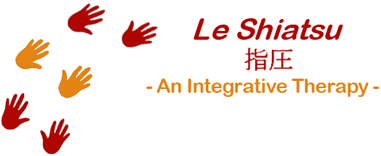-
I have seen pictures of Shiatsu done on the floor. Will it be the case?
-
You speak about "self-care" and lifestyle adjustments, what do you mean?
-
I heard of an acupuncturist who prescribes herbal remedies. Do you as well?
-
Is Shiatsu based on a religion or esoteric system of belief?
Note: more FAQs on Acupuncture will be added soon.
How should I prepare for my Shiatsu Treatment?
No specific preparation is needed. Just make sure you can describe your symptoms (e.g. where does it hurt, when & how did it start, what makes it worse). If you have been given a diagnosis by your doctor, it will be useful information.
Before your first treatment only, you will be asked to sign a consent to treatment (where you agree to be the receiver of Shiatsu treatments). You should also fill a card with your medical history (past diseases, injuries/trauma, surgeries) and current conditions, including the medications you are taking. Before each treatment, you will be asked what your main issue(s) or chief complaints(s) are. [Top of Page]
Shiatsu treatments are done through clothing. Wear comfortable cotton outfits. Thick fabrics like blue jeans or heavy woolen sweaters make it more difficult for the therapist to palpate and more challenging to loosen muscle and tissue tensions, so they are best avoided. Also, you may be asked to empty your pockets, remove your belt, watch or jewelry. [Top of Page]
I have seen pictures of Shiatsu done on the floor. Will it be the case?
Traditionally in Japan, Shiatsu is practiced on a mat, on the floor. Le Shiatsu treatments are usually given on a comfortable massage table, especially when it is difficult for people to sit or lie on the floor. But floor is a possibility for people who are comfortable with it. [Top of Page]
What happens during a Shiatsu treatment?
There are typically three phases:
-Intake: the therapist looks at your card and discusses your medical history and chief complaints with you. The therapist may observe your posture & gait, look at your tongue, ask further questions, palpate areas of tension, or take your pulse. You may also be asked to make specific moves such as raise your arm to check your range of motion.
-Treatment: typically a Shiatsu treatment starts with palpation of the belly. The abdomen, or Hara in Japanese, is where important centers of Qi and organ reflexes are located. They are palpated for assessing Qi imbalances and for treating them. Then depending on your situation, the treated body areas and their order of treatment varies. Typical treatment positions are face-up, face-down, sides, and sitting. Typical treated areas are the abdomen, the legs & feet, the whole back, the arms & hands, the neck, and the head.
-Wrap-up: at the end of the treatment, the therapist may provide additional information about your situation and the treatment. Recommendations for life style adjustments or gentle exercises or stretches may be given to you as home work. Finally upon your leaving, the therapist fills a treatment card so that documentation is available for your future treatments. [Top of Page]
In general Shiatsu is a very relaxing experience. Many people at some point drift into sleep. You may also feel a comfortable "good" pain. When treating an irregular area of your body, it is best to apply just enough pressure to trigger a response but below the pain threshold. You may feel a clear sensation of relief from the pressure. Do not hesitate to provide feedback. Your therapist will listen and adjust pressure or posture to keep you comfortable at all times while triggering a good response. In Shiatsu the saying "no pain is no gain" does not apply. Inform your therapist of any discomfort or pain you are experiencing. [Top of Page]
How I am going to feel after the treatment?
Most people leave relaxed, feeling energized, alert, less tense, peaceful, or sleepy. Range of motion is usually increased. Pain may be reduced. Though it is rare, unexpected reactions may occur. For instance if you feel nauseated, lightheaded, excessively emotional, or dizzy during treatment, please tell your therapist immediately.
On some occasions, someone may experience tiredness, or muscular soreness which should not last more than a few hours to two days. Sometimes an unexpected reaction may occur such as a headache or heavy menstrual flow. The oriental tradition speaks of a "healing crisis". As tensions or imbalances work their way out of your body, some symptoms may flare up as part of the healing process. If you have any question, or if such a reaction lasts more than a couple of days, please let your therapist know. [Top of Page]
You speak about "self-care" and lifestyle adjustments, what do you mean?
Some habits may be part of what causes issues and symptoms. Your therapist may question you about posture at work, diet, exercise programs, sleep and other aspects of your lifestyle. The therapist may have recommendations about them. As part of the Shiatsu training, therapists understand their main impact and how to adjust them to the specifics of your situation. Should a detailed consultation on e.g. nutrition or herbal remedies seem appropriate, you may be suggested to see someone of that field.
As part of the recommended self-care, you may be shown simple stretches or exercises and advised to do them regularly. The Shiatsu therapist knows which ones can positively impact either a structural issue (e.g. muscle tension or stiffness, alignment and posture), or stimulate the flow of Qi along a specific set of meridians. There are meridian stretches specific to Shiatsu. Each of them targets a pair of meridians and their corresponding organs. [Top of Page]
How many treatments will I need?
The number and frequency of treatments depends upon your individual condition.
In general, a recent and acute condition will require just a few treatments, maybe one to three. A long-standing or chronic condition may require more, possibly five to ten. You should notice immediate positive effects from the beginning, but a condition that has developed over a period of months to years needs time, repeated treatments and self-care to change.
For conditions such as fibromyalgia, nervous diseases or degenerative disorders, regular Shiatsu helps many sufferers to function better in their life, to have more energy and experience less pain.
Finally, many people who enjoy good health make Shiatsu part of their health maintenance program and come for biweekly or monthly sessions.
Based on your situation and your goals, your Shiatsu therapist will advise you of the number and frequency of treatments that are appropriate for you. [Top of Page]
I am pregnant; can I receive Shiatsu?
Yes if your doctor is comfortable about it. If he/she is unsure about what Shiatsu exactly is, ask if you can get massage and acupuncture treatments and if so, Shiatsu is fine. If you experience serious complications related to your pregnancy, it may be better not to receive Shiatsu.
In general, Shiatsu can be an excellent contribution to your health program during this privileged period. Your body adapts to the new demand of carrying and developing the fetus. Shiatsu can help with overall stamina and the symptoms that often occur such as morning sickness, low back pain, and heavy legs. Your Shiatsu therapist will devise a treatment strategy tailored to your situation. For instance, treatment position and treated areas are adjusted to be safe and beneficial. There are specific aspects to pay attention to and your therapist knows about them. The therapist will make sure that the treatment is safe, beneficial and that you remain comfortable at all times. [Top of Page]
What are the contraindications to Shiatsu?
If you have a severe disease, this is best checked with your doctor. If he/she is unsure about what Shiatsu exactly is, ask if you can get massage and acupuncture treatments and if so, Shiatsu is fine. Your Shiatsu therapist will be able to advise honestly whether there is any risk or if Shiatsu is unlikely to help much with your condition.
Overall Shiatsu is very safe because there is no manipulation and only gentle pressure and stretching in comfortable positions.
In general, Shiatsu is contraindicated (i.e. it might not help much or even have a negative impact) to people who have an acute illness with fever (cold, flu or other), in particular when the infection just started. During this more severe and contagious phase, the body is already engaged fighting off the infection and should not be overloaded. In addition, the person may be contagious to others.
If you have high blood pressure, heart rhythm trouble or diabetes and these are not controlled, then Shiatsu is likely contraindicated.
Areas of your body with local open wounds, recent scars, inflammation, varicose veins etc. will be avoided during the treatment and are local contraindications. Please let your therapist know and mention all such areas. They may be hidden by clothing and invisible to the therapist who, once informed, will not touch or press them.
In some rare situations, your therapist may decide it is best that you see a doctor first, based on information gathered by questioning or palpating (e.g. growth of unknown origin, recent unexplained weight gain or loss etc.). [Top of Page]
Do you keep my information confidential?
Of course! We keep detailed records of the treatment information to serve you better. We keep track of the reasons for your visit, of changes and progress etc. But this data and the fact that you visited us is never communicated. It is archived in a secure environment. In the instance that you would like us to provide information about your situation to another therapist or healthcare provider, you should specifically let us know and we will need your explicit consent. The only two reasons we would communicate information are: if required by law, or if explicitly requested by you. [Top of Page]
CST stands for Certified Shiatsu Therapist. A CST® is your assurance of the most highly trained Shiatsu therapist in Canada and North America. The CST® certification is granted by the Shiatsu Therapy Association of Ontario (STAO). It means that the therapist has a diploma from a 2,200 hours Shiatsu program (2 year full time or equivalent). In addition, the therapist had to write an exam with the STAO that comprises a theoretical and practical part. Being a member of the STAO and a certified therapist ensures treatments follow the highest standards. A CST® has agreed in writing to abide by the association's code of ethics and is subject to the association's complaints and disciplines procedures. [Top of Page]
I heard of an acupuncturist who prescribes herbal remedies. Do you as well?
In some cases, herbal remedies may be a good adjunct to your Shiatsu treatments. If so, we may recommend that you see someone of that field, for instance a doctor in Chinese medicine or a doctor of naturopathy. Your Shiatsu therapist will not prescribe them. [Top of Page]
Is Shiatsu based on a religion or an esoteric system of belief?
No. It is true that Shiatsu was developed as a clinical therapy in countries where the culture differs from our Western culture. We are becoming more and more familiar with their important concepts such as Yin and Yang. The notion of Qi or energy is used throughout the Eastern medical system. It is not attached to any religious belief. Eastern doctors do not make assumptions about the origin of Qi or the creation of life. They have based their medical principles on centuries of clinical observations and carefully articulated a coherent system. Shiatsu therapists come from all cultural and religious backgrounds. Their motive is to provide professional and compassionate care, and help people on their path towards better health. [Top of Page]

